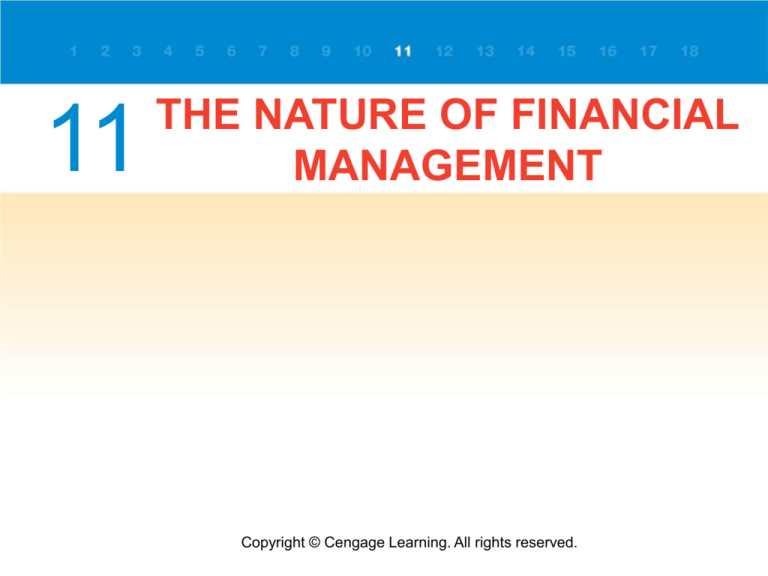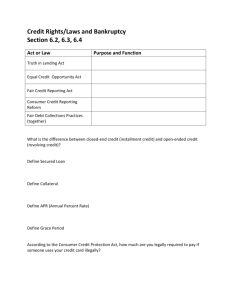
11
THE NATURE OF FINANCIAL
MANAGEMENT
Copyright © Cengage Learning. All rights reserved.
11.2
Installment Buying
Copyright © Cengage Learning. All rights reserved.
Installment Buying
Two types of consumer credit allow you to make installment
purchases. The first, called closed-end, is the traditional
installment loan.
An installment loan is an agreement to pay off a loan or a
purchase by making equal payments at regular intervals for
some specific period of time.
There are two common ways of calculating installment
interest. The first uses simple interest and is called add-on
interest, and the second uses compound interest and is
called amortization.
3
Installment Buying
In addition to closed-end credit, it is common to obtain a
type of consumer credit called open-end, revolving credit,
or, more commonly, a credit card loan.
MasterCard, VISA, and Discover cards, as well as those
from department stores and oil companies, are examples of
open-end loans.
This type of loan allows for purchases or cash advances up
to a specified maximum line of credit and has a flexible
repayment schedule.
4
Add-On Interest
5
Add-On Interest
The most common method for calculating interest on
installment loans is by a method known as add-on
interest.
It is nothing more than an application of the simple interest
formula.
It is called add-on interest because the interest is added to
the amount borrowed so that both interest and the amount
borrowed are paid for over the length of the loan.
6
Add-On Interest
You should be familiar with the following variables:
P = AMOUNT TO BE FINANCED (present value)
r = ADD-ON INTEREST RATE
t = TIME (in years) TO REPAY THE LOAN
I = AMOUNT OF INTEREST
A = AMOUNT TO BE REPAID (future value)
m = AMOUNT OF THE MONTHLY PAYMENT
N = NUMBER OF PAYMENTS
7
Add-On Interest
8
Example 1 – Find a monthly payment
You want to purchase a computer that has a price of
$1,399, and you decide to pay for it with installments over 3
years. The store tells you that the interest rate is 15%.
What is the amount of each monthly payment?
Solution:
You ask the clerk how the interest is calculated, and you
are told that the store uses add-on interest.
Thus, P = 1,399,
r = 0.15,
t = 13, and N = 36.
9
Example 1 – Solution
cont’d
Two-step solution
I = Prt
= 1,399(0.15)(3)
= 629.55
A=P+I
= 1,399 + 629.55
= 2,028.55
10
Example 1 – Solution
cont’d
One-step solution
A = P(1 + rt)
= 1,399(1 + 0.15 3)
= 2,028.55
The amount of each monthly payment is $56.35.
11
Annual Percentage Rate (APR)
12
Annual Percentage Rate (APR)
Suppose you borrow $2,000 for 2 years with 10% add
on-interest. The amount of interest is
$2,000 0.10 2 = $400
Now if you pay back $2,000 + $400 at the end of two years,
the annual interest rate is 10%.
However, if you make a partial payment of $1,200 at the
end of the first year and $1,200 at the end of the second
year, your total paid back is still the same ($2,400), but you
have now paid a higher annual interest rate.
13
Annual Percentage Rate (APR)
Take a look at Figure 11.1.
Interest on a $2,000 two-year loan
Figure 11.1
14
Annual Percentage Rate (APR)
On the left (figure 11.1) we see that the interest on $2,000
is $400. But if you make a partial payment (figure on the
right), we see that $200 for the first year is the correct
interest, but the remaining $200 interest piled on the
remaining balance of $1,000 is 20% interest (not the
stated 10%).
Note that since you did not owe $2,000 for 2 years, the
interest rate, r, necessary to give $400 interest can be
calculated using I = Prt:
(2,000)r(1) + (1,000)r(1) = 400
15
Annual Percentage Rate (APR)
3,000r = 400
This number, 13.3%, is called the annual percentage rate.
16
Example 3 – Find an APR for a installment purchase
In Example 1, we considered the purchase of a computer
with a price of $1,399, paid for in installments over 3 years
at an add-on rate of 15%. Use the given APR formula
(rounded to the nearest tenth of a percent) to approximate
the APR.
Solution:
Knowing the amount of the purchase is not necessary
when finding the APR.
17
Example 3 – Solution
cont’d
We need to know only N and r. Since N is the number of
payments, we have
N = 12(3) = 36, and r is given as 0.15:
The APR is approximately 29.2%.
18
Open-End Credit
19
Open-End Credit
The most common type of open-end credit used today
involves credit cards issued by VISA, MasterCard,
Discover, American Express, department stores, and oil
companies.
Because you don’t have to apply for credit each time you
want to charge an item, this type of credit is very
convenient.
When comparing the interest rates on loans, you should
use the APR.
20
Open-End Credit
Earlier, we introduced a formula for add-on interest; but for
credit cards, the stated interest rate is the APR.
However, the APR on credit cards is often stated as a daily
or a monthly rate. For credit cards, we use a 365-day year
rather than a 360-day year.
21
Example 6 – Find APR from a given rate
Convert the given credit card rate to APR (rounded to the
nearest tenth of a percent).
a. per month
b. Daily rate of 0.05753%
Solution:
a. Since there are 12 months per year, multiply a monthly
rate by 12 to get the APR:
22
Example 6 – Solution
cont’d
b. Multiply the daily rate by 365 to obtain the APR:
0.05753% 365 = 20.99845%
Rounded to the nearest tenth, this is equivalent to
21.0% APR.
23
Open-End Credit
Many credit cards charge an annual fee; some charge $1
every billing period the card is used, whereas others are
free.
These charges affect the APR differently, depending on
how much the credit card is used during the year and on
the monthly balance.
If you always pay your credit card bill in full as soon as you
receive it, the card with no yearly fee would obviously be
the best for you.
24
Open-End Credit
On the other hand, if you use your credit card to stretch out
your payments, the APR is more important than the flat fee.
For our purposes, we won’t use the yearly fee in our
calculations of APR on credit cards. Like annual fees, the
interest rates or APRs for credit cards vary greatly.
Because VISA and MasterCard are issued by many
different banks, the terms can vary greatly even in one
locality.
25
Credit Card Interest
26
Credit Card Interest
An interest charge added to a consumer account is often
called a finance charge.
The finance charges can vary greatly even on credit cards
that show the same APR, depending on the way the
interest is calculated.
There are three generally accepted methods for calculating
these charges: previous balance, adjusted balance, and
average daily balance.
27
Credit Card Interest
28
Example 7 – Contrast methods for calculating credit card interest
Calculate the interest on a $1,000 credit card bill that shows
an 18% APR, assuming that $50 is sent on January 3 and is
recorded on January 10. Contrast the three methods for
calculating the interest.
Solution:
The three methods are the previous balance method,
adjusted balance method, and average daily balance
method. All three methods use the formula I = Prt.
29
Example 7 – Solution
cont’d
30
Credit Card Interest
Many credit cards charge no interest if you pay in full within
a certain period of time (usually 20 or 30 days). This is
called the grace period.
On the other hand, if you borrow cash on your credit card,
you should know that many credit cards have an additional
charge for cash advances—and these can be as high as
4%. This 4% is in addition to the normal finance charges.
31




